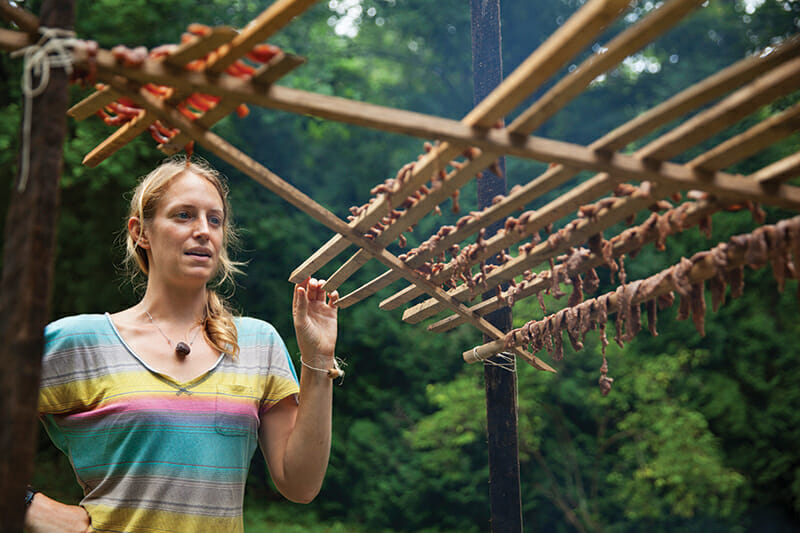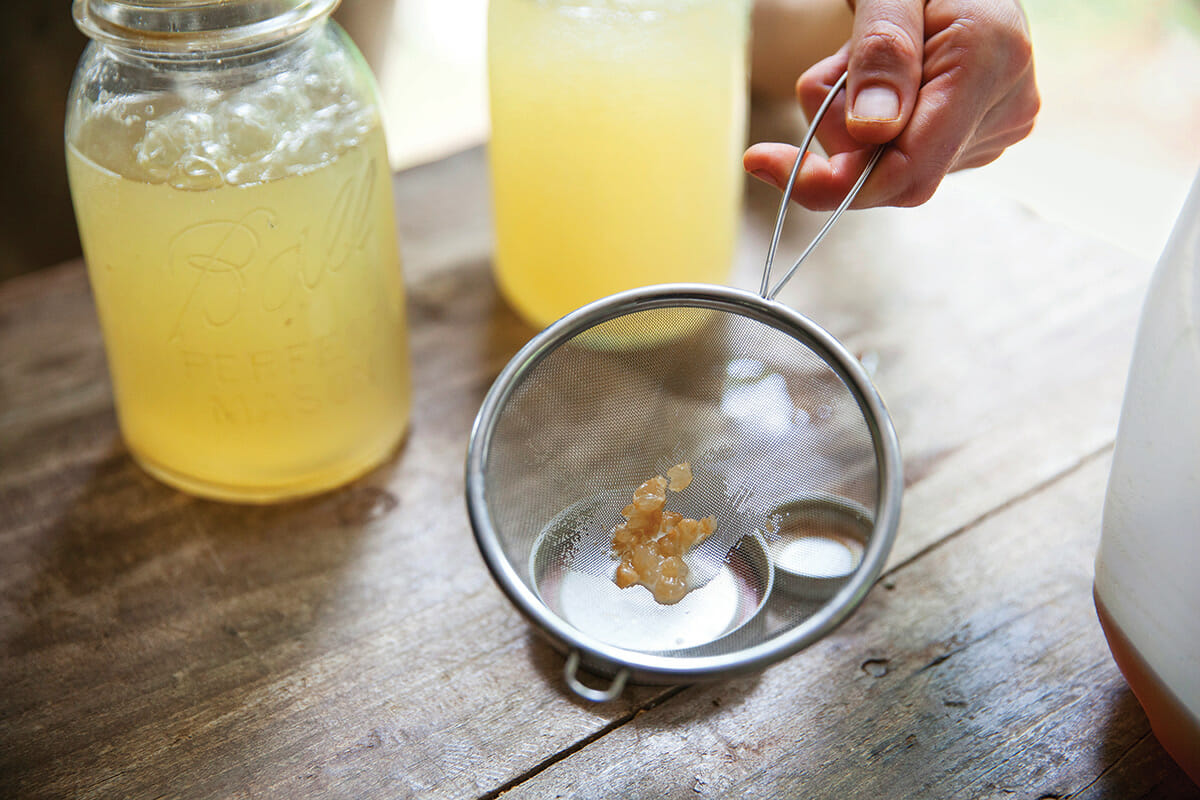Fermentation Farm
The oldest form of food preparation makes a return.
An hour outside of Nashville, Tennessee, down a dirt road and up a steep, curving hill in the woods, you’ll find fermentation guru Sandor Katz in a solar-powered log cabin cooking goat testicles for lunch.
The 12 students accepted to Katz’s early summer 3-week fermentation residency eagerly crowd around the kitchen table, watching him trim and slice the bulbous product, a gift from a nearby farmer friend. “They look kind of like onions?” one student muses. Surprising these students isn’t easy.
Making water kefir, a fizzy fermented drink, at fermentation expert Sandor Katz’s summer residency.
Students gather at Katz’s solar-powered log cabin in rural Tennessee.
They have come from as far as Costa Rica and Germany to pitch tents outside this log cabin and learn, in essence, how to incubate bacteria and grow mold into edible delicacies from the master himself.
Meet Sandor Katz this weekend!
Sandor Katz will be in Boston this weekend, making a multicourse fermented brunch. Dishes will include cherokee fermented corn, sunflower petal marmalade and kimchi-pickled egg. Also: a “pickle off” throwdown. More details here.
It’s hard to call one of the oldest forms of food preparation a trend, but home fermentation has been rising in popularity in recent years, among everyone from health-conscious foodies to high-end chefs. This is in part an effort to reclaim something lost in the generations raised on convenience and processed foods. “In the last 15 years, we’re waking up,” says Katz, who rose to prominence with the best-selling cookbooks “Wild Fermentation” and “The Art of Fermentation.” “Now it’s, OK, convenience is great, but what are the downsides? It’s nutritionally deficient? Are the methods for more production environmentally destructive?”
The answers to these questions are driving more and more people to the kitchen. Katz’s kitchen, in particular.

Katz’s residents, for reasons varying as much as their origins, find themselves incubating tempeh by day and sleeping in tents in rural Tennessee by night. There are professional chefs and amateur enthusiasts. One student works for hospice care in Oregon, another is a nurse from Cincinnati, Ohio. They came to satisfy their own curiosity, to improve their understanding of the science of edible bacteria, to get healthier and to reclaim what they consider a lost art. Many came because they want to be more self-sufficient in a world of uncertainty – uncertain weather, growing conditions and food sourcing.
“My boyfriend and I are committed to growing our own food,” says Eileen Richardson, a young chef who enrolled in the residency to help her prepare to open a kombucha café in a fermentation bar in Denver. “We don’t feel safe depending on anyone else. I want to be self-sufficient in a real way. It’s empowering.”
It’s hard to call one of the oldest forms of food preparation a trend, but home fermentation has been rising in popularity.
Katz, who is 52 and sports a striking, bushy mustache, grew up on the Upper West Side of Manhattan with parents who were both good cooks, his father the more experimental of the two. After attending Brown University, where he studied history, Katz worked at the Manhattan Borough President’s Office.
“I was a policy wonk,” he laughs. But in 1991, he was diagnosed with HIV, and by 1993, he’d left the city for Cannon County, Tennessee. That’s where he got into fermentation. Eating live-culture foods, he says, has been a part of his healing. In Tennessee he lived in an intentional community of largely queer men, women and transgendered people on 200 acres of lush, off-grid land – and began to garden. “And suddenly there was this row of cabbage and I wanted to do something with it,” he says. “I was a city kid. I hadn’t thought of what would happen when a row of cabbage is all ready at the same time, that fleeting abundance of the garden.”
He started with sauerkraut. He made so much sauerkraut, he says, friends called him “Sandorkraut.”
The cabin’s rustic kitchen.
A vat of ginger beer sweetened with a starter called ‘ginger bug.’
The fermentation library in Katz’s cabin.
A crock of fermenting sauerkraut.
Fermentation is now his life’s work. When he began teaching fermentation workshops, Katz was surprised’by the fear exhibited by his students, namely a fear of bacteria. To combat the notion (as he writes in “The Art of Fermention”) that bacteria are “our enemies,” he holds classes and workshops around the world, traveling for roughly half of the year. His books have won James Beard Awards and been New York Times bestsellers. “‘The Art of Fermentation’ is an inspiring book, and I mean that literally,” writes Michael Pollan in the forward. “The book has inspired me to do things I’ve never done before, and probably never would have done if I hadn’t read it.”
“He lives his teaching,” says Laura Killingbeck, one of Katz’s fermentation residents, who traveled to Tennessee from Costa Rica, where she cooks for a ranch community. “I aspire to that.”
After the goat testicle lunch, the students again surround the kitchen table, watching Katz demonstrate how to make a wild hodgepodge of fermented beverages.
Sandor Katz in his element.
This group of residents came from as far as Germany and Costa Rica for Katz’s three-week fermentation residency in the hills outside of Nashville, TN.
First he pours a bubbling vat of sweetened raspberry liquid through a sieve into old Pepsi bottles; the next day it will be a lightly carbonated soft drink. He transfers another vigorously bubbling crock of liquid – a mead, made with’only honey, water and grapes – into a glass carboy to ferment. (“Half of the alcohol happens in the first week to 10 days,” he says). He hands out samples of a tropical beer called “mavi,” a rye bread-based drink called “kvass” and a kombucha, or fermented sweet tea, the class made the day before. (“It’s beginning to taste alive!” he says happily.) Together,’the class starts on a ginger beer, made with a starter called a “ginger bug.”
“How much sugar did you put in?” asks Mike Moyer, the nurse from Cincinnati, who sits shirtless on a stool in the muggy Tennessee heat.
“Good question,” says Katz, shrugging. Fermentation, after all, is as much art as science.
Top image: Water kefir is made by adding “grains,” small symbiotic communities of bacteria and yeasts, to a sugar-water solution.
Follow us

This work is licensed under a Creative Commons Attribution-NoDerivatives 4.0 International License.
Want to republish a Modern Farmer story?
We are happy for Modern Farmer stories to be shared, and encourage you to republish our articles for your audience. When doing so, we ask that you follow these guidelines:
Please credit us and our writers
For the author byline, please use “Author Name, Modern Farmer.” At the top of our stories, if on the web, please include this text and link: “This story was originally published by Modern Farmer.”
Please make sure to include a link back to either our home page or the article URL.
At the bottom of the story, please include the following text:
“Modern Farmer is a nonprofit initiative dedicated to raising awareness and catalyzing action at the intersection of food, agriculture, and society. Read more at <link>Modern Farmer</link>.”
Use our widget
We’d like to be able to track our stories, so we ask that if you republish our content, you do so using our widget (located on the left hand side of the article). The HTML code has a built-in tracker that tells us the data and domain where the story was published, as well as view counts.
Check the image requirements
It’s your responsibility to confirm you're licensed to republish images in our articles. Some images, such as those from commercial providers, don't allow their images to be republished without permission or payment. Copyright terms are generally listed in the image caption and attribution. You are welcome to omit our images or substitute with your own. Charts and interactive graphics follow the same rules.
Don’t change too much. Or, ask us first.
Articles must be republished in their entirety. It’s okay to change references to time (“today” to “yesterday”) or location (“Iowa City, IA” to “here”). But please keep everything else the same.
If you feel strongly that a more material edit needs to be made, get in touch with us at [email protected]. We’re happy to discuss it with the original author, but we must have prior approval for changes before publication.
Special cases
Extracts. You may run the first few lines or paragraphs of the article and then say: “Read the full article at Modern Farmer” with a link back to the original article.
Quotes. You may quote authors provided you include a link back to the article URL.
Translations. These require writer approval. To inquire about translation of a Modern Farmer article, contact us at [email protected]
Signed consent / copyright release forms. These are not required, provided you are following these guidelines.
Print. Articles can be republished in print under these same rules, with the exception that you do not need to include the links.
Tag us
When sharing the story on social media, please tag us using the following: - Twitter (@ModFarm) - Facebook (@ModernFarmerMedia) - Instagram (@modfarm)
Use our content respectfully
Modern Farmer is a nonprofit and as such we share our content for free and in good faith in order to reach new audiences. Respectfully,
No selling ads against our stories. It’s okay to put our stories on pages with ads.
Don’t republish our material wholesale, or automatically; you need to select stories to be republished individually.
You have no rights to sell, license, syndicate, or otherwise represent yourself as the authorized owner of our material to any third parties. This means that you cannot actively publish or submit our work for syndication to third party platforms or apps like Apple News or Google News. We understand that publishers cannot fully control when certain third parties automatically summarize or crawl content from publishers’ own sites.
Keep in touch
We want to hear from you if you love Modern Farmer content, have a collaboration idea, or anything else to share. As a nonprofit outlet, we work in service of our community and are always open to comments, feedback, and ideas. Contact us at [email protected].by Molly Birnbaum, Modern Farmer
September 24, 2014
Modern Farmer Weekly
Solutions Hub
Innovations, ideas and inspiration. Actionable solutions for a resilient food system.
ExploreExplore other topics
Share With Us
We want to hear from Modern Farmer readers who have thoughtful commentary, actionable solutions, or helpful ideas to share.
SubmitNecessary cookies are absolutely essential for the website to function properly. This category only includes cookies that ensures basic functionalities and security features of the website. These cookies do not store any personal information.
Any cookies that may not be particularly necessary for the website to function and are used specifically to collect user personal data via analytics, ads, other embedded contents are termed as non-necessary cookies.
